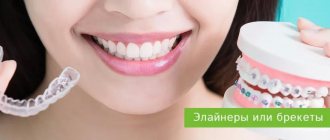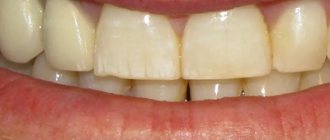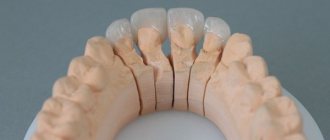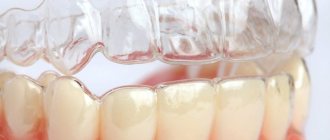08/17/2020 Veneers or braces?
Braces are the most popular design for correcting uneven teeth.
They are plates made of metal, plastic, ceramic or artificial sapphire, which are connected by a metal arc. Under the pressure of the arch, the teeth move into the correct places, and the bite is corrected. However, there is another method of correcting the bite - masking defects in the front teeth using thin ceramic plates - veneers.
Veneer installation
Let's look at both of these methods and find out in which cases it is worth installing braces, and in which cases - veneers.
Efficiency
Braces
Braces are still relevant precisely because of their effectiveness - metal structures can cope with almost any malocclusion. They cannot cope with only the most serious ones, which require surgical treatment.
Braces are effective for open bites, forward or backward displacement of the lower jaw, crowded teeth, and most other problems.
This applies specifically to metal braces. Braces made of ceramic, plastic or sapphire cannot cope with some anomalies - they are too fragile to put a high load on them.
Veneers
Veneers are designed primarily to create a whiter smile, so their functionality is much lower. They do not correct anything, but only mask defects, and exclusively in the area of the front teeth: incisors, canines and first premolars.
With the help of veneers, you can close the gaps between the teeth, lengthen the crowns a little and hide small irregularities. Veneers will not help with open, mesial, distal or deep bites.
Before and after braces
Before and after veneers
In case of serious malocclusion, it is necessary to install braces. Small gaps between teeth and abnormalities in the smile area can be closed with veneers.
Myofunctional correction
Speech therapist-myofunctional therapist T.B. Zukor conducted an analysis of the functioning of the facial muscles. There was a noticeable imbalance in muscle function. Normalization of muscle tone is necessary, since, firstly, the retainers will have to be removed for about a month to carry out dental restoration, and secondly, after the completion of dental restoration, the issue of maintaining stable results of orthodontic treatment (which was completed in 2022) must be resolved, and here Retainers do not always cope with the task of holding teeth in place (see example of the appearance of a gap between teeth even with a retainer).
Myofunctional exercises were prescribed, which the patient performed before removing the retainer (the correction was carried out in parallel with dental treatment so that the patient did not waste time).
Aesthetics
Braces
Classic metal braces are noticeable on the teeth. Nowadays they are made smaller than before, but they are still visible when smiling and talking, and this cannot be avoided. For greater aesthetics, patients install braces made of plastic, ceramic or artificial sapphire, but they are still noticeable due to the metal arch and not a perfect match to the enamel. So in terms of aesthetics, braces definitely lose.
There are completely aesthetic lingual braces that are placed on the back surface of the teeth. They are absolutely invisible, but expensive and inconvenient, and also do not cope with all malocclusions.
Lingual braces
Veneers
Veneers are not just aesthetic - they create the aesthetics of a smile. Ceramic plates mask not only uneven teeth, but also stains on the enamel, yellowed teeth, small chips and cracks. They make teeth perfectly white, creating that very popular “Hollywood” smile, which cannot be achieved with any whitening. Veneers can restore front teeth after chipping, trauma, or decay due to caries, as well as hide tetracycline teeth and enamel damage due to fluorosis.
Before and after installation of veneers
Braces are generally noticeable and unaesthetic, but veneers make your smile perfect.
Benefits and harms
It is important to understand that the pros and cons of veneers directly affect the quality of your bite. Thus, without much effort, you can visually correct minor imperfections and ensure a whiter and brighter smile. And this is without grinding down the incisor, only with the removal of a thin layer of enamel. If all the rules are followed, the plate will need to be replaced only after 10-20 years - the positive effect is obvious.
On the other hand, abandoning them after the first fixation is already problematic. You have to wear them for the rest of your life, periodically lightening them or putting on new ones. Why? Because 0.5-0.7 of the natural protective coating has already been removed. And the same premolars under microprostheses may ache, because after dental treatment they will become more sensitive and will react more sharply to hot and cold food.
So you should carefully weigh the pros and cons before deciding to have your smile corrected.
Comfortable to wear
Braces
Unfortunately, wearing any braces is quite inconvenient. First you need to get used to them - the first two weeks, pressure on the teeth causes pain and impairs diction. Then, during treatment, you need to limit your diet - do not eat too viscous and hard foods: nuts, carrots, seeds. Cleaning them is also not easy - you need to clean the space around the braces and under the arches with special brushes and brushes.
Brushes for cleaning teeth
In addition, sometimes braces scratch the gums and mucous membranes of the cheeks (and lingual braces scratch the tongue). Of course, the pain can be eliminated with painkillers, diction will quickly be restored, and the mucous membrane is protected by gluing wax to the protruding parts of the braces, so all problems can be solved, but it is still quite inconvenient. However, patients note that new compact braces made of metal, ceramic or sapphire quickly become “familiar”, and after a month they do not cause any particular inconvenience (except for the need for lengthy cleaning).
Veneers
Veneers are glued to natural teeth so that they become an inseparable part of them. They do not spoil diction and usually do not cause pain or discomfort - only in the first couple of weeks the teeth sometimes ache under the veneers, but this is the consequence of grinding the enamel. Veneers do not require special cleaning and do not require any special dietary restrictions. They can crack if you bite through hard objects, but this also applies to natural teeth, so in general everything remains as is.
In terms of wearing comfort, veneers are significantly ahead of braces.
Types of veneers
Various tasks that the dentist solves when installing veneers require the use of the appropriate category and material of the artificial onlay.
Therapeutic veneers are made from composite. They are applied to the treated tooth in layers, successfully imitating tooth enamel, but still imperfect. Once every six months, polishing is required because the composition becomes rough and ceases to reflect light evenly with the rest of the teeth, standing out in the row. The difference is not very critical at first, but can become stronger over the years.
Such veneers in the mouth require the patient to reduce the content of foods with bright pigmentation in the diet. Therapeutic veneers are fragile and require careful handling. Capable of chipping under intense loads. They are attached primarily to the front incisors. They are installed directly in the dentist’s office and are relatively cheap.
Orthopedic veneers are more expensive, require preliminary preparation, and are manufactured by special laboratories using impressions of the patient’s teeth. The material is porcelain or ceramics, which reliably imitates the color and characteristics of natural tooth enamel. Service life is more than one decade. Orthopedic veneers are the easiest way to achieve a perfect smile.
Luxneers -
New generation veneers do not require grinding of teeth. If desired, you can remove Luxniers from a dentist, returning to your natural teeth.
Contraindications
Braces
There are practically no contraindications to braces. They cannot be placed in case of serious diseases of the oral cavity, as well as in case of mental disorders, due to which the patient cannot properly care for his teeth or is capable of breaking the structure. But in general, braces are available for almost any situation.
Veneers
There are several contraindications to installing veneers. They should not be installed if too much stress is placed on the front teeth. This happens in the absence of sixes or sevens, or due to the habit of gnawing hard objects (nails, pens, seeds). Also, veneers cannot be placed if most of the front tooth was once restored with a filling, that is, it is severely damaged. In case of severe malocclusion, veneers cannot be installed either, since they cannot be placed evenly, and there is no point in installing them crookedly.
Veneers are also contraindicated for those who engage in boxing and other contact sports - they can easily crack. In case of bruxism and mental illness, it is also better not to use them.
Veneers have many more contraindications than braces.
This work was performed by Dial-Dent specialists:
- Orthopedic dentist S.V. Zukor – diagnostics, development of a comprehensive treatment plan, ceramic dental prosthetics.
- Dentist-endodontist – treatment of dental caries with a microscope, treatment of dental canals with a microscope.
- Myofunctional therapist T.B. Zukor – myofunctional correction to balance the work of the facial muscles, normalization of the tongue position, breathing exercises to strengthen nasal breathing.
- Dental hygienist E. Smirnova – conducting professional oral hygiene, selecting the most effective home hygiene products, correcting self-brushing skills.
- Dental ceramic technician – D.V. Wolf – manufacturing of dental crowns and ceramic veneers.
- Dental assistants - L. Kharlamova, A. Antoshkina.
See other examples of the work of Dial-Dent specialists here.
Make an appointment by phone +7-499-110-18-02 or through the form on the website. You can ask questions to the chief physician of the clinic, Sergei Vladimirovich Tsukor, at
Possible complications
Braces
Braces can cause the following complications:
- Pain and discomfort immediately after braces are installed.
- Damage and inflammation of the mucous membrane due to injury from protruding parts of the structure.
- Plaque and tartar due to insufficient cleaning. May lead to gum inflammation.
- Caries due to insufficient cleaning.
- Stains on the enamel after removing braces. They appear if the braces were not glued tightly enough and plaque got under them.
- Increased sensitivity of teeth after removal of the structure.
All these complications can be avoided if you visit the dentist with any problems and brush your teeth thoroughly.
Veneers
Usually there are no problems after installing veneers. To install them, you need to grind down the enamel, so the teeth may ache a little for the first couple of days, but this goes away quickly. There are no other complications.
Veneers are not only more comfortable to wear, but also safer, since there are no problems with them.
Installation age
Braces
Braces can be installed after the age of 12, when all baby teeth have fallen out. To correct the bite of children under 12, plates and removable mouth guards are used. There is no upper threshold - braces are effective in correcting bites in adults as well. The treatment period in this case increases from six months to 1–2 years.
Braces for a child
Veneers
Veneers are permanent, so they can only be placed after the age of 18–20, when the jaw stops growing. If you place them earlier, the teeth may move a little further apart, and the aesthetic effect of the veneers will disappear. There is no upper limit either.
Braces can be installed in childhood, veneers are only suitable for adults.
Seriously speaking, it is best to be treated with aligners
Yes, I want to book a free consultation on aligners in my city!
If braces and veneers - we all understand that they are visual and what they are, then aligners
- These are the lightest transparent mouthguards made of solid polymer.
When you put on the aligners, you see your entire dentition (the aligners become invisible).
And this is a plus for aligners
Also, the advantages of aligners include the absence of allergies, just like veneers. Braces cannot boast of this.
By the way, you can find out in 1 minute whether aligners are right for you or whether doctors will forcibly offer only braces: you need to answer only 9 express questions
.
But the main general advantage of braces is that they can be installed in childhood. Although, according to the scientific development department of Star Smile, aligners are now being developed for children from 7 years of age. If this works out, then the undisputed leadership in the overall comparison will go to the aligners.
Preservation of teeth
Braces
We have already mentioned above that braces can damage the enamel - after they are removed, sometimes stains remain, and caries and gums often have to be treated. But if the braces are installed correctly, and you carefully took care of your teeth during the two years of wearing them and visited the dentist to remove plaque, then problems may not arise, and the enamel will remain intact.
Veneers
Veneers in general only improve the appearance of teeth, and also protect hypersensitive enamel from the action of chemical and thermal irritants. But in order to install veneers, the enamel needs to be sharpened. This means that if the veneer suddenly breaks, it will be impossible to simply remove it - the tooth underneath will remain “bare”, and a veneer will have to be placed on top again.
In the case of thin lumineers or ultraneers, grinding is not necessary, so the enamel is not damaged at all. However, the cost of such structures is much higher.
Veneers require grinding down the enamel, which means they seriously damage it, but at the same time protect the teeth. Damage to teeth after braces depends on how you care for them, so there is no clear leader here.
Duration of treatment
Braces
Braces need to be worn for about six months in adolescence and 1.5–2 years in adults. Sometimes minor defects in adults can be corrected within six months or a year, but this is rare. For serious anomalies, longer wearing is sometimes indicated. In addition, after treatment is completed, you will need to wear a retainer - a removable or permanent plate that will hold the teeth in their new position. You need to wear it twice as long as the treatment lasted, and sometimes for the rest of your life, however, it does not cause much discomfort.
Veneers
Veneers are installed only permanently, but wearing them cannot be called treatment in the full sense of the word. They do not cause discomfort, do not require you to follow any rules, that is, they are essentially similar to fillings. In addition, veneers correct your bite instantly after installation - you don’t need to wait a year for the result, your teeth will immediately be visually straight.
Veneers correct the bite instantly, wearing them is not a treatment, so in this regard they are definitely better than braces.
Intimate disadvantage of all braces
We specifically highlighted this minus as a separate item. Doctors are tactfully silent about this drawback of any brace systems, including lingual braces. But it exists. And it causes a lot of problems for those with braces. This is an injury, but not to the tongue, but to injury by parts of the braces to the mucous membrane of the sexual partner during intimate caresses: causing micro-scratches with possible infection of the wounds due to insufficient hygiene of the braces.
Such statistics are periodically published in the European and American press, where they really and openly talk about it. With veneers and aligners, this problem is absent or minimized: we always try to clean our teeth normally, but with braces it becomes more and more difficult to clean.
How are aligners made - invisible aligners for teeth?
To make aligners, the doctor at the clinic takes impressions of the patient’s jaws and sends them to the manufacturer of the aligners - to us, to the Star Smile company. Using a 3D scanner, a digital model of the teeth is obtained. The trajectory of the teeth is calculated and the required number of aligners is determined - from five to several dozen aligners. It all depends on the severity of the primary pathology.
The video shows how the digital jaw rotates, some lines appear along which the teeth line up. And soon this digital model will begin to come to life in the aligners. Star Smile has developed a unique software simulation of dental biomechanics. You see on the screen how all the lines are aligned, how the patient’s gums precisely move along with the teeth on the screen. This is very important - after all, future aligners should not cause any inconvenience and should fit perfectly on the patient, that is, unnoticed, producing the maximum effect of correcting the bite.
Next stage
— an order for future aligners is sent for 3D printing. Work on the production of aligners is carried out using 3D printers. As a result of digital 3D printing, accurate models of the patient’s teeth are obtained. Models of blanks for aligners are made step by step, that is, already in the dynamics of future treatment; for each stage, a different set of teeth is made.
Next stage
— a vacuum former comes into operation for the production of aligners. Blanks are placed on a special vacuum former mold - prototypes of future aligners. Thanks to super high-tech plastic, these blanks are light, transparent and will be invisible on the teeth.
Next stage
— the aligners acquire their exact geometry and are completely tailored to the anatomical features of the patient’s teeth and gums.
Finish stage
— packaging of manufactured aligners. All aligners are placed in individual sterile bags, listed according to the period of their wearing, and the patient’s name. The aligners have already acquired their own individuality.
All that remains is to put all the individual packages in the Star Smile branded box and the order is sent to your treating orthodontist at your dentistry.
How orthodontists install aligners
And so your aligners came to the doctor. In this video, orthodontist Alexey Trezubov talks in detail about the installation of aligners and shows how the aligners are installed and worn:
Patient reviews
Braces
Reviews about braces in adults are quite contradictory. Many people are satisfied with the results, and wearing modern braces usually does not cause inconvenience. Those who wear ceramic or sapphire braces note their high aesthetics - often the structures are not even noticeable during a conversation. Lingual braces are also popular, especially among public people, although even in positive reviews people note that it is difficult to get used to them.
There are also negative reviews about braces. People generally do not like the length of treatment, the pain in the first few weeks and the trauma to the mucosa. In addition, some write that even when wearing a retainer, the teeth still move slightly apart. And if you don’t wear a retainer, the bite quickly returns to its previous state, and you have to be treated again.
Veneers
Reviews about veneers are almost entirely positive. They are often placed to make teeth whiter, but there are also those who use them to slightly correct their bite, for example, to close a diastema. People especially like the immediate results and the fact that veneers are very comfortable to wear.
Patients consider the high price to be their only drawback. In addition, it is worth considering that they are simply not used by people with serious bite defects, since they will not help in this situation.
How long will you have to wear the structure?
Only a doctor can tell you how long to wear retainers For one person a year is enough, for another it will take several years. You can only estimate approximate times: to do this, multiply the time you spent with the bite correction system by two. The average is from 3 to 6 years, but everything is very individual.
There are exceptions in which there are no strict terms for wearing a retainer after braces . If the process of muscle training is very slow, you will have to walk with the plate all your life.
What to choose
Let’s summarize the above criteria and indicate in which situations it is worth installing veneers, and in which – braces:
| Situation | -What to put |
| Small irregularities, gaps between the front teeth | -Veneers |
| Malocclusions, uneven front and side teeth | -Braces |
| The result is needed as quickly as possible | -Veneers |
| Maximum aesthetics is important | -Veneers, lingual braces |
| I don’t want to worry too much about hygiene and experience inconvenience | -Veneers |
| Patient age up to 18-20 years | -Braces |
| It is necessary to correct the bite as cheaply as possible | -Metal braces |
For serious anomalies - braces, for weak ones - veneers.











